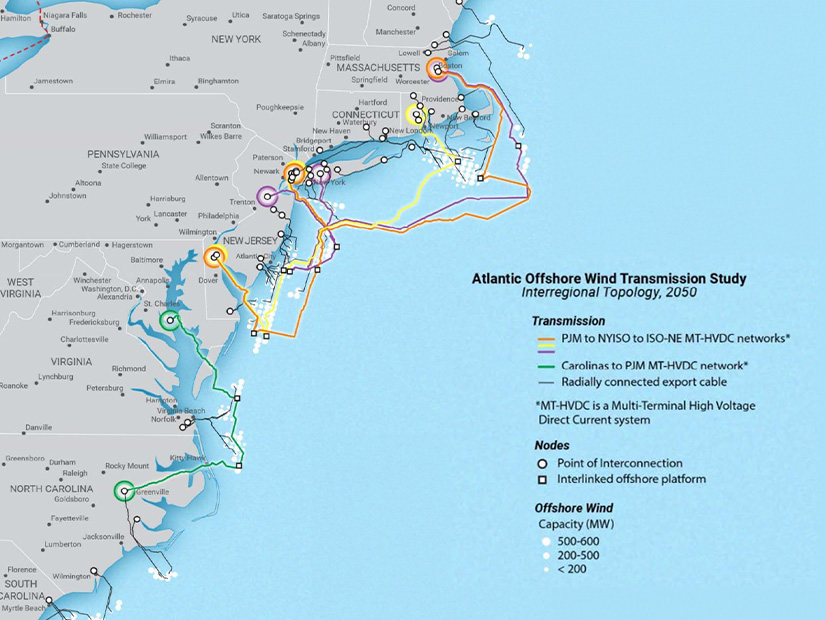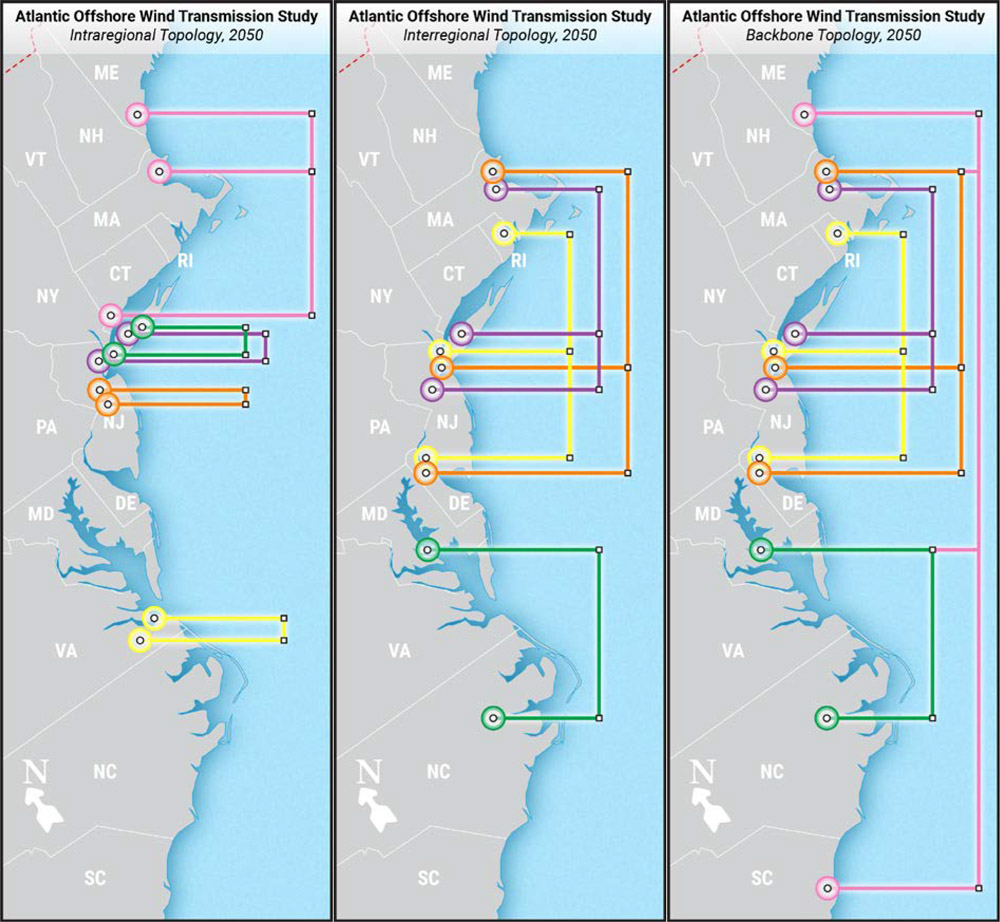
An interregional transmission network for the East Coast’s offshore wind could produce almost $1.6 billion annually in generation savings and improved reliability versus radial lines, according to a study released by the U.S. Department of Energy last week.
The Atlantic Offshore Wind Transmission Study calculated substation and cable costs for a 2050 “low-carbon” scenario with 85 GW of offshore wind from Maine to South Carolina. The analysis considered four offshore transmission topologies against a reference case using radial lines for each project with no links between offshore platforms:
-
- an intraregional topology with connections within regions;
- an interregional topology connecting diverse regions;
- an inter-intra topology combining the links in the interregional and intraregional topologies; and
- a backbone grid that adding interregional plan an additional cable running from Maine to South Carolina.
The analysis, by researchers from the National Renewable Energy Laboratory and the Pacific Northwest National Laboratory, found that each of the four networked topologies had higher benefits than costs and that the interregional plan produces the highest benefit-to-cost ratio and total net value.
Networking offshore transmission would reduce offshore wind curtailments (1 to 2 percentage points below the radial topology) and the use of higher-cost generators, DOE said. It would also increase reliability by providing alternatives during outages of other transmission lines or generation, particularly during winter peak conditions.
“In modeled estimates using the radial topology in 2050, price differences between suitable POIs for offshore wind averaged over $100/MWh,” the report said. “This price difference is higher than the average wholesale electricity prices in recent years in some Atlantic market regions. High price differences indicate that offshore transmission with interlinking platforms can consistently flow power from lower- to higher-price regions to benefit electricity consumers by reducing the costs of generating electricity.”
The researchers’ modeling of the networked transmission showed that flows on all interlinks go both directions every season, with an average utilization rate of 50 to 60% of the available capacity on each line. An interregional grid with a 14,000-MW capacity could displace up to 4,700 MW of firm generation capacity, the researchers said.
The base radial plan is estimated to cost $96.3 billion. The interregional grid would add $11.4 billion in capital costs, with annualized capital and operations and maintenance costs of $840 million. But DOE said it would produce benefits of $2.4 billion annually, a benefit-to-cost ratio of 2.9.
The backbone topology provides the second-largest ratio of 2.7, with annualized costs of $1.47 billion and benefits of $3.9 billion per year.
The analysis envisions building offshore transmission in phases to reduce development risk and assumes the first offshore wind projects would be connected to the grid with individual radial lines. But researchers said, “early implementation of high-voltage direct current (HVDC) technology standards is essential for future interoperability.”
The only potential negative identified by researchers: Offshore wind could be vulnerable to extreme weather in the ocean and at landing points.
DOE’s report adds to earlier research on the benefits of a planned Atlantic offshore grid, including a 2023 Brattle study that estimated coordinated transmission planning could produce at least $20 billion in transmission-related cost savings, 60 to 70% fewer shore crossings and a reduction of about 50% in marine transmission cables (2,000 fewer miles) on the seabed. (See OSW Transmission Planning Must be Interregional, Networked and Start Now.)
Implementation Steps
DOE’s study was accompanied by an action plan from DOE’s Grid Deployment Office that identifies the steps researchers said would be required to implement the transmission buildout. It calls for establishing collaborative bodies spanning the Atlantic Coast this year to plan transmission and cost allocation during the second half of the decade.
It encourages RTOs and other transmission providers to simultaneously evaluate multiple benefits beyond reliability or production cost savings.
In its transmission planning and cost allocation rulemaking, which FERC is expected to finalize this year, the commission proposed developing long-term scenarios for use in regional planning, with an increased role for states in facility selection and cost allocation. FERC has also proposed a minimum set of benefit categories with methods to quantify them (RM21-17). (See FERC Watchers Weigh in as Transmission Rule Approaches Finish Line.)
Among the “Immediate Actions Before 2025” in the action plan is voluntary cost-allocation assignments. “Transmission cost allocation is a notoriously thorny issue that is intensified by the scale of projects and large price tags associated with interconnecting offshore wind,” DOE said. “In fact, the Business Network for Offshore Wind [recently renamed the Oceantic Network] described the issue of who pays as ‘the hardest single problem for transmission.’”
‘Most Thorough Analysis’ to Date
DOE called its two-year study the most thorough analysis to date of options to bring the East Coast’s wind energy — projected to be a key part of the region’s decarbonization — ashore.
The study focused on the offshore region between Maine and South Carolina and the onshore grid in those states, plus Vermont and Pennsylvania due to their proximity to the Atlantic. The 85-GW scenario for 2050 projects 27 GW of OSW injection into ISO-NE; 19 GW into NYISO, 26 GW into PJM and North Carolina, and 13 GW into the SERC Reliability Corp. region in North Carolina and South Carolina. Offshore wind would represent more than 20% of generation in NYISO and PJM and more than 40% in ISO-NE.
The report identifies potential transmission corridors considering environmental concerns and other uses such as military zones and shipping channels. The researchers cautioned that their analysis did not have the level of detail of interconnection studies and was not intended to prescribe exact injection points.




